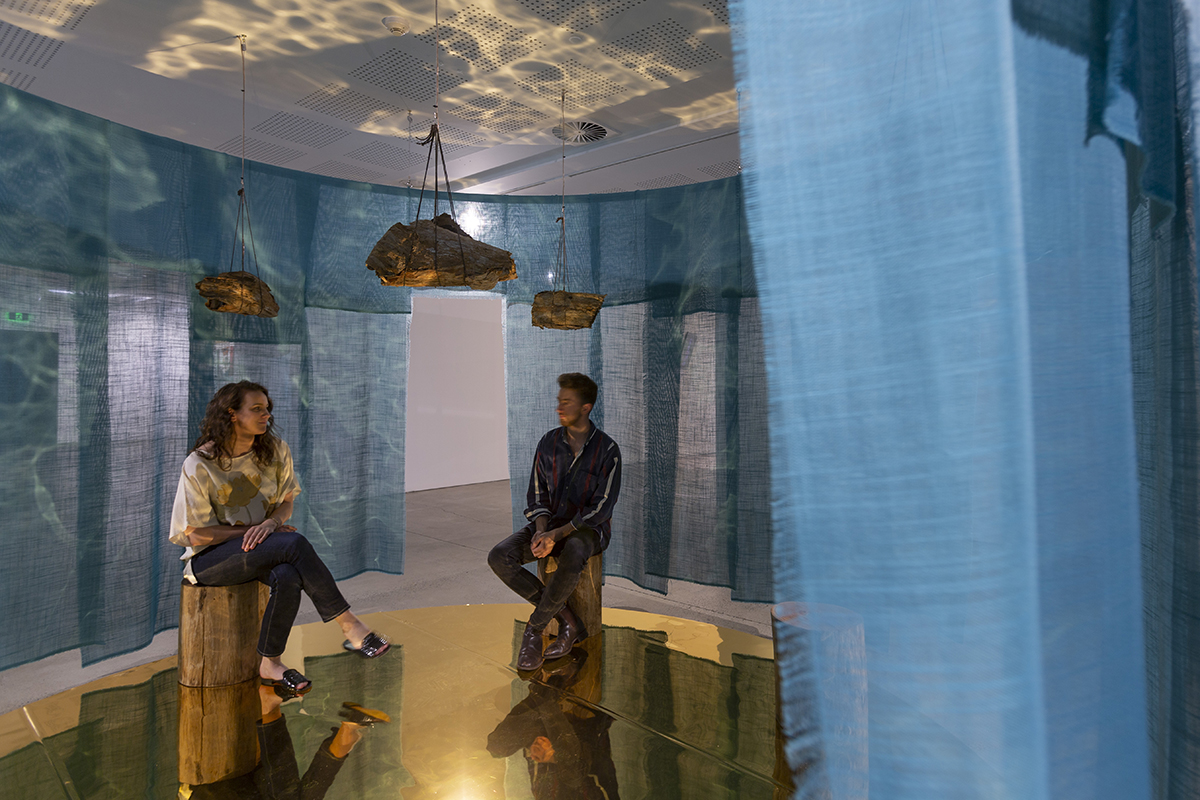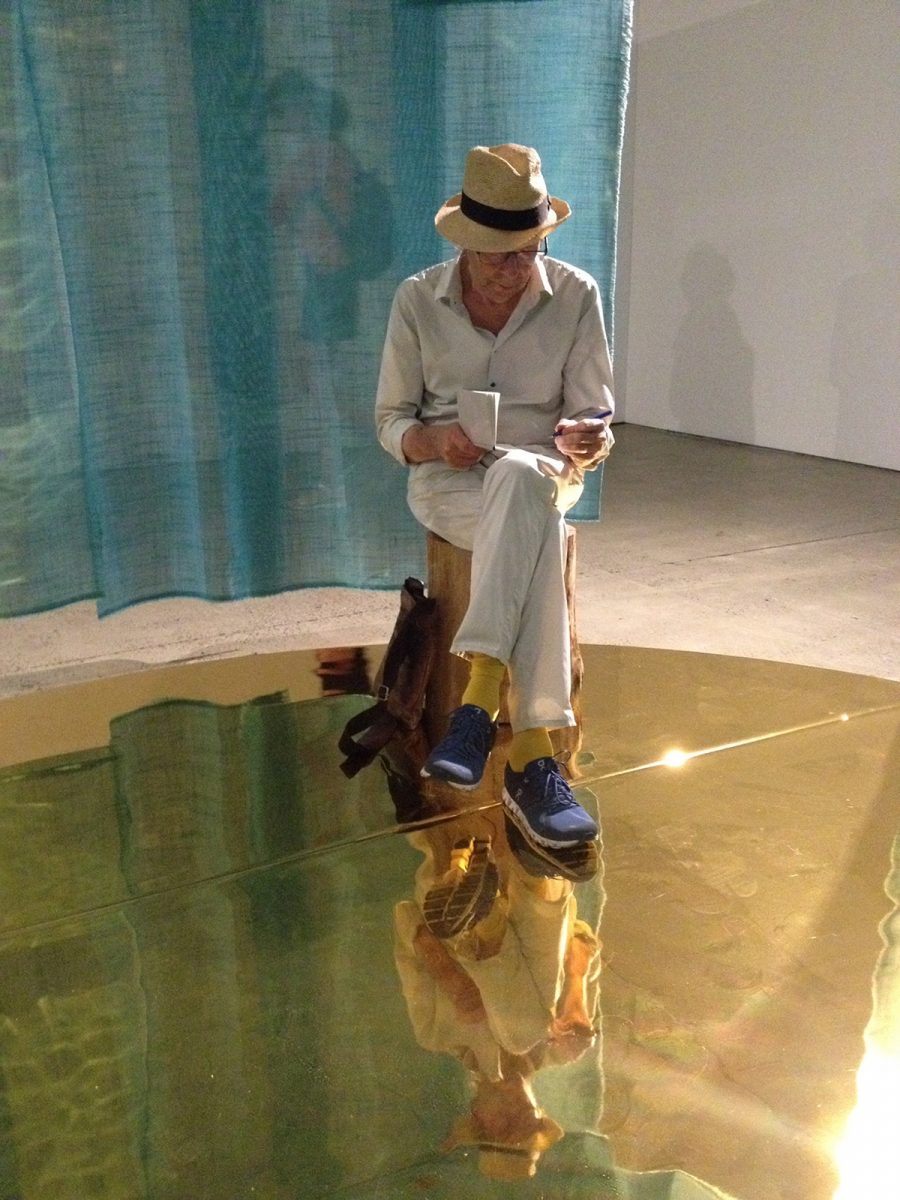
The Big Anxiety 1: listen_UP, listen deep
On a reflective golden floor, six tree stumps for sitting. Above, six small boat-like objects crafted from paperbark float serenely. A soft, blue cloth curtain gently encloses the intimate, circular space. The floor dips deep beneath the sitter, mirroring all that is above in the contemplative space that is listen_UP, an installation in The Big Anxiety’s Empathy Clinic. The work advocates and induces deep listening with which to understand the anger and underlying grieving born of serial trauma suffered by generations of Australia’s Indigenous peoples. As a soft crackling suggests a gentle fire at listen_UP’s centre, a very present, lone female voice, pondering inherited and personally experienced suffering, is textured with heartbeat, the rumble of restless weather and a singer expressively uttering a mutating syllable sequence emotionally in tandem with the speaker’s narrative in a sound world of gently shifting perspectives.
The speaker struggles to begin—“I am… I am…”—but the words come—“I am without hope, without future”—revealing “a pain so deep, shame of what I am, what you have made me.” She is “a child unloved,” who has introjected her oppression: “I knew that I deserved not to be loved.” She briefly proffers an explanation for white listeners’ inability to empathise: “You cannot see me… because I mirror your pain.” While her plight is existential—“To be nothing would be preferable to being”—she is compassionate for children “raped in welfare, in a world where multinationals trade in weapons.” Unable to wait for revolution, she declares she will start with herself. The singer intones “reya, reya…”
Suddenly there’s particularity, the speaker revealing her profession, declaring “university a prison without walls.” As an academic, “I build walls of paper to bury my grieving soul while children are dying.” These children are close by, “crying down the street.”
However, a sense of purpose emerges with metaphor enriching the sense of passion inherent in the quietly controlled voice: “I am fire… I am stinging nettle.” “Will you accept the need for this pain?” she asks the listener. “Illy, illy,” sings the singer. Moving beyond metaphor, doubtless drawing on her spiritual heritage, the speaker declares herself owl, spider and “goanna full of healing.” Perhaps we can now travel with her: “I hear so many songs, I will wait for you.”
Finally, the speaker, no longer “I” but “we,” celebrates “the bliss of being completely a woman” through, she says, women’s shared words, dance and song. The singer’s “eeya, eeya…” becomes “eeya, eeya, num, num…” conveying a sense of both completion and eternal duration. I have no idea what these syllables (loosely transcribed here) mean, if anything literal, but the beauty of the intensifying ritual framing they offer lends choral power to the speaker’s path from anger and despair to survival through art, amid resonating wind, thunder and rain, distant bird call and the rattling of cicadas.
The speaker is much admired Emeritus Professor Judy Atkinson AM, a Jiman/Bundjalung woman of also Anglo-Celtic and German heritage. She is the author of Trauma Trails—Recreating Songlines (Spinifex Press, 2003): The transgenerational effects of Trauma in Indigenous Australia, and founder of We Ali-li, a Culturally Informed Trauma Integrated Healing training organisation.
The pioneering visual and media artist r e a has worked with Atkinson “to create an aural campfire—a place where stories are shared, listened to, understood and then reflected or meditated on. In culture the campfire is a creative learning and teaching space where elders pass on their knowledge and stories to listeners young and old” (program note). To focus and intensify this listening r e a has textured Atkinson’s voice with the artistry of Nardi Simpson (composer and singer with Stiff Gins), Missi Mel Pesa (audio-visual artist, musician and composer) and Andrew Belletty (self-described “vibro-tactile sound artist”).
Andrew Belletty kindly spoke with me about listen_UP’s embracingly natural sound design: the six small directional speakers encased in paperbark, keeping the technology invisible; the “grounding campfire” centre speaker; the two gently enveloping sub-bass speakers outside the circle; occasional sounds—birds, insects—including those from field trip recording in r e a’s country; and a realised desire to have the listener feel intimately and directly addressed by Atkinson, mouth to ear.
Listen_UP is a generous invitation to sense, via a contemplative space (exhibition designer Anna Tregloan) and aural magic, how Australia’s Indigenous peoples, as a young We Ali-li participant has put it, “we use our anger, we recycle it, we use it as power for us… to make beautiful things out of your anger, out of your hate, out of your sadness” (We Ali-li website).
–
The Big Anxiety, first staged in 2017, is a festival that “brings together artists, scientists and communities to question and re-imagine the state of mental health in the 21st century” (website). Artistic and Executive Director Professor Jill Bennett (UNSW), Producer Tanja Farman, Senior Curator Bec Dean.
The Big Anxiety: r e a and Judy Atkinson: The Empathy Clinic, listen_UP, artists r e a, Nardi Simpson, Missi Mel Pesa, Andrew Belletty; UNSW Galleries, Sydney, 23 Sept-9 Nov
Top image credit: Installation, Listen_UP, r e a and Judy Atkinson, The Big Anxiety, photo Jessica Maurer







